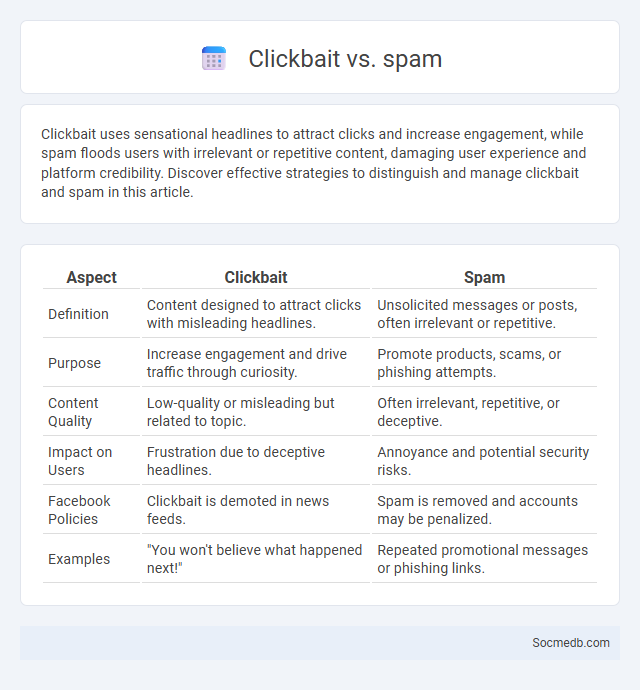
Photo illustration: Clickbait vs spam
Clickbait uses sensational headlines to attract clicks and increase engagement, while spam floods users with irrelevant or repetitive content, damaging user experience and platform credibility. Discover effective strategies to distinguish and manage clickbait and spam in this article.
Table of Comparison
| Aspect | Clickbait | Spam |
|---|---|---|
| Definition | Content designed to attract clicks with misleading headlines. | Unsolicited messages or posts, often irrelevant or repetitive. |
| Purpose | Increase engagement and drive traffic through curiosity. | Promote products, scams, or phishing attempts. |
| Content Quality | Low-quality or misleading but related to topic. | Often irrelevant, repetitive, or deceptive. |
| Impact on Users | Frustration due to deceptive headlines. | Annoyance and potential security risks. |
| Facebook Policies | Clickbait is demoted in news feeds. | Spam is removed and accounts may be penalized. |
| Examples | "You won't believe what happened next!" | Repeated promotional messages or phishing links. |
Understanding Clickbait: Definition and Purpose
Clickbait refers to sensationalized or misleading headlines designed to attract clicks and drive high engagement on social media platforms. Its primary purpose is to generate traffic by appealing to users' curiosity and emotions, often at the expense of delivering substantive or accurate content. Understanding clickbait helps you recognize manipulative tactics, improving your ability to critically evaluate the reliability of online information.
What is Spam? Key Characteristics
Spam on social media refers to unsolicited or irrelevant messages sent in bulk, often promoting products, services, or malicious links. Key characteristics include repetitive content, deceptive tactics to gain clicks or personal information, and the rapid spread across multiple accounts or platforms. Your interaction with spam can lead to security risks, reduced user experience, and the cluttering of online feeds.
Clickbait vs Spam: Core Differences
Clickbait uses sensational headlines designed to capture Your attention and encourage clicks by promising intriguing or exaggerated content, often leading to valuable or entertaining information. Spam, on the other hand, consists of unsolicited, irrelevant messages or links that clutter social media feeds and often aim to deceive or promote scams. Understanding these core differences helps You navigate social platforms more effectively, avoiding harmful content while engaging with legitimate posts.
How Clickbait Works: Techniques and Examples
Clickbait leverages sensational headlines and emotionally charged language to trigger curiosity, compelling users to click on links. Techniques include using ambiguous phrasing, promising exclusive content, or exaggerating facts to create a sense of urgency or mystery. Examples range from phrases like "You won't believe what happened next" to misleading thumbnails designed to maximize engagement and ad revenue.
The Impact of Spam on User Experience
Spam on social media platforms significantly degrades user experience by flooding feeds with irrelevant or malicious content, making it harder for users to discover meaningful information. Persistent spam reduces engagement rates as users grow frustrated with intrusive advertisements and fraudulent messages. Effective spam detection and removal algorithms are critical to maintaining platform integrity, user trust, and overall satisfaction.
Comparing Clickbait and Spam: Motivations and Tactics
Clickbait leverages curiosity and emotional triggers to entice You into clicking links by exaggerating content or using sensational headlines, aiming primarily to boost engagement and ad revenue. Spam employs unsolicited, repetitive messages designed to overwhelm or deceive users, often with malicious intent such as phishing or spreading malware. Understanding these distinct tactics helps You recognize and avoid manipulative content, enhancing your social media experience and security.
Recognizing Harmful Clickbait Content
Recognizing harmful clickbait content on social media involves identifying misleading headlines designed to trick users into clicking without delivering valuable information. Common signs include exaggerated claims, sensational language, and deceptive thumbnails that do not accurately represent the content. Awareness of these tactics helps users avoid misinformation and reduce the spread of low-quality, manipulative posts across platforms like Facebook, Twitter, and Instagram.
Preventing Exposure to Spam Online
Implementing robust spam filters and setting strict privacy controls are essential for preventing exposure to spam on social media platforms like Facebook, Instagram, and Twitter. Users should regularly update their account security settings and avoid engaging with suspicious links or messages to reduce the risk of phishing attempts and malware. Leveraging AI-driven algorithms to detect and block spam content enhances user safety and maintains platform integrity.
Ethical Implications: Clickbait vs Spam
Clickbait exploits users' curiosity with misleading headlines, manipulating engagement metrics and eroding trust in social media platforms. Spam inundates users with irrelevant or repetitive content, degrading user experience and overwhelming content filters. Both practices raise ethical concerns by compromising content authenticity and user decision-making on networks like Facebook, Twitter, and Instagram.
Best Practices for Responsible Online Content Creation
Creating responsible online content involves prioritizing accuracy, respecting privacy, and fostering positive engagement. Content creators should verify facts before sharing information, avoid spreading misinformation, and attribute sources properly to maintain credibility. Emphasizing respectful communication and considering the impact on diverse audiences helps build trust and promotes a healthier social media environment.
 socmedb.com
socmedb.com